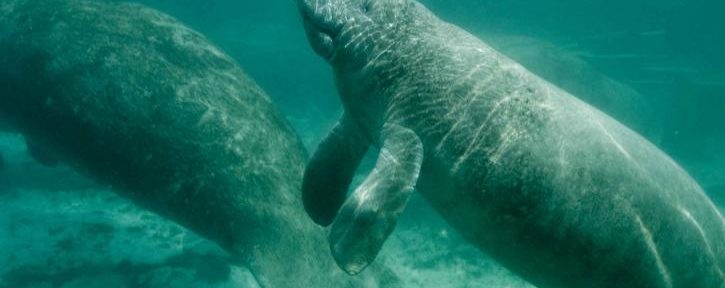by Monica Starr
The state of Florida has described the high number of manatee deaths an “unusual mortality event.” These herbivorous marine mammals can often be found in the central and south Atlantic coast of Florida. The Florida Fish and Wildlife Conservation Commission or the FWC has reported nearly 650 manatee deaths from January 2021 to April 2021. [1] Martine de Wit, the veterinarian with FWC originally attributed the increase of deaths to stress from cold water temperatures. It was explained that these manatees are very sensitive to even the slightest change in water temperature, and during the winter months in Florida it dropped below 68 degrees numerous times. Interestingly, the deaths are not occurring in these cold waters. Needing warmer temperatures, manatees have been traveling to warmer waters like the Indian River Lagoon. This is an estuary that is located just north of Orlando and stretches down to the Jupiter Inlet on the Atlantic coast. This area is where most of the deaths are occurring, which is why this event is so alarming to marine biologists and veterinarians in the region.
Historically, the stress from cold waters only really impacted juvenile manatees. One of the explanations for this event could be that the adult manatees are starving due to the lack of seagrass available, which is their main source of nutrition. These marine plants are often impacted by water pollution. Agricultural chemicals, fertilizers and leaking septic tanks flow into this lagoon every year and the water quality has gotten progressively worse, but it has acted as a warm environment for the manatees during the cold winter months in the past. Typically, manatees need to consume about 10% of their body weight each day in either seagrass or other aquatic plants. [2] Without access to the proper nutrition, these beautiful sea cows will continue to die off. This is just one example of how a decrease in water quality can impact various species in the food web.
Legal protection of manatees actually dates back to the 18th century in Florida, making these protection laws some of the oldest in American history. [2] During the mid-1900s, there were only a few hundred documented manatees, and by 1967, the U.S. Department of the Interior placed the Florida manatee on the original list of species protected by the Endangered Species Preservation Act.[2] That being said, in 2017 the U.S. Fish and Wildlife Service removed the Florida manatee from the Endangered Species Act list.
Grassroots efforts made by local communities in the Indian River Lagoon area have been working to clean up the water for years. In 2016, the residents in Brevard County voted for a $300 million tax to finance a 10-year clean-up project which includes planting mangroves, starting/maintaining oyster gardens and other outreach programs getting the community involved. WJXT News explains a few reminders for locals and tourists staying in the area including:
- Follow the posted speed zones
- Avoid the seagrass beds in shallow areas
- Do not feed the manatees
And if you see a sick, injured or dead manatee please contact the FWC at 1-888-404-3922.
Sources and Additional Reading
Monica Starr is an intern with Ecology Florida, serving as the Public Communications Facilitator for Ecology Florida News. Monica is a graduate student at the University of South Florida studying Global Sustainability.
[1] https://www.news4jax.com/news/local/2021/04/17/floridas-manatees-dying-at-alarming-rates/
[2] https://www.nationalgeographic.com/animals/article/430-florida-manatees-have-died-in-2021


Leave a Reply